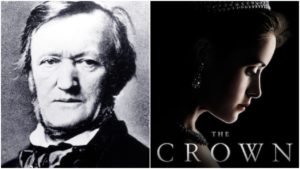
Opera Meets Film: How Wagner’s Liebestod Explores Love In Different Stages in ‘The Crown, Season 1: Episode 3’
By David Salazar“Opera Meets Film” is a feature dedicated to exploring the way that opera has been employed in cinema. We will select a section or a film in its entirety, highlighting the impact that utilizing the operatic form or sections from an opera can alter our perception of a film that we are viewing. This week’s installment features Netflix’s “The Crown, a TV series.”
“Love. It is the greatest thing on Earth.”
So says former King Edward to Winston Churchill near the end of the third Episode of “The Crown” as he defends his marriage and how it altered his position within the Royal Family.
No sooner has he uttered these words that we hear a woodwind downbeat commencing the Liebestod from Wagner’s “Tristan und Isolde.” Arguably the most yearning of Wagner’s music takes charge of an exquisite montage that brings together the three central romantic relationships at the core of this particular episode.
As the instrumental version of the Liebestod takes charge the camera cuts from a wide shot between the two men in a darkly lit room, to a flowing shot inside a silhouetted room, the sun’s light shining through the window to create a romantic buzz from the lens flares. In the center of the image are two figures dancing, Edward and Wallis. To this point, Edward, who is making his first appearance in the series, has been locked in emotional combat with the rest of his family over his marriage to Wallace, a divorcee; he was once the King and was forced to abdicate to avoid scandal. But he holds strong to his love for her throughout the episode, defending it to the last.
After a series of images of their love, the film cuts to a shot following Princess Margaret as she heads to Peter Townsend’s office. Earlier in the episode, she was forced to hide in his office while Phillip went to consult with his flight instructor. Their relationship has been a game of hide and seek throughout, a portrayal of playful and suspenseful desire that she adds fuel to when she walks in, accompanied by Wagner’s blossoming score, and gives him a passionate kiss. Then she walks out.
From there, the montage shifts focus to the central couple of the episode – Elizabeth and Philip, both heading to the opera, presumably to see “Tristan und Isolde.” The entire episode has been built on the tension of the royal family’s name. Phillip has wanted to use his family name of Montbatten, something Elizabeth has supported.
However, she has been pressured from all sides to continue using the name Windsor, which would gravely disappoint her husband. As they sit in the opera box, Elizabeth and Phillip exchange a few glances; she’s upset but he doesn’t know why. The music continues, but its mixing in the score is slightly different, somehow losing some of its shine and feeling a bit hollow with the reverberations added; something is off.
At the end of the scene, Elizabeth smiles at her husband, the music retakes it original sound mix and cuts back to a final image of Edward and Wallis kissing, bringing the montage to bookend that brings all of the emotions of the characters together.
The music lingers on as Edward arrives at the Palace to meet with Elizabeth and as he enters the room, Wagner’s music, without ever managing to ramp up to its climax, ends on an unresolved note. It’s perfect for Wagner’s own intentions and suits the entire context rather well. The tension that has arisen out of all these love affairs has not yet been resolved.
This montage, through Wagner’s music and how it juxtaposes three different relationships undergoing different stages of their development, provides a perfect emotional recap to the tumult of emotions experienced throughout the episode. It also, in a way, explores the commonality between three different characters that are seemingly at odds throughout. Margaret, by connection with her mother, has no interest in Edward due to his position in the family. But the same holds true for Elizabeth.
And yet, right at the emotional climax of the episode, right before the former King is to meet the new Queen, they are connected because they are both fighting to protect “the greatest thing on Earth.”
It shouldn’t surprise anyone that their ensuing scene together plays more on this sense of connection than it does division with the two eventually finding mutual understanding.
Categories
Opera Meets Film

